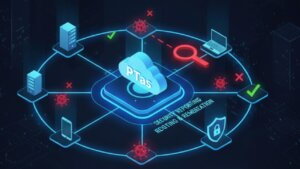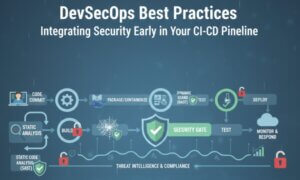APIs are the backbone of modern applications, enabling seamless data exchange between services, platforms, and devices. However, this ubiquity also opens up multiple avenues for cyberattacks. In response, organizations are turning to artificial intelligence (AI) and machine learning (ML) to bolster API security, enabling real-time threat detection and rapid response. In this blog, we will explore how AI-powered API security is transforming the way organizations safeguard their digital assets, ensuring threats are identified and neutralized instantly.
Book Your FREE Security Consultation Today!
The Evolution of API Security
API security has traditionally involved manual testing, static code analysis, and rule-based detection methods. While these approaches have been effective to some degree, they often fall short in the face of sophisticated and rapidly evolving cyber threats. Cybercriminals continually adapt their strategies, exploiting vulnerabilities like Broken Object Level Authorization (BOLA), injection attacks, and excessive data exposure. These evolving threats demand a dynamic, intelligent defense mechanism—one that can analyze vast amounts of data, detect anomalies, and respond in real time.
Enter AI and ML. By integrating these advanced technologies into API security, organizations can automate threat detection, reduce false positives, and ultimately protect their systems with unprecedented speed and accuracy.
How AI and ML Enhance API Security
1. Real-Time Anomaly Detection
One of the key advantages of using AI in API security is its ability to detect anomalies in real time. Traditional methods rely on predefined rules, which can be easily bypassed by attackers employing novel tactics. AI-powered systems, on the other hand, learn the normal behavior patterns of API traffic and can instantly flag deviations. For example, if an API endpoint suddenly experiences an unusual spike in requests or an unexpected pattern in query structures, AI can immediately alert security teams, allowing them to investigate and mitigate potential threats.
2. Automated Threat Response
Speed is of the essence when it comes to thwarting cyberattacks. AI-driven platforms are capable of not only detecting threats but also automating responses to minimize damage. For instance, upon identifying suspicious activity, an AI system can automatically throttle traffic from the offending IP address, trigger multi-factor authentication (MFA) challenges, or even temporarily block access until further analysis is conducted. This rapid response mechanism can significantly reduce the window of opportunity for attackers.
3. Continuous Learning and Adaptation
Cyber threats are dynamic and constantly evolving. One of the challenges in maintaining effective API security is the need to keep up with these changes. Machine learning algorithms address this by continuously learning from new data and adapting to emerging threats. As the system processes more API traffic, it refines its models, improving its accuracy over time. This continuous learning process ensures that the security posture remains robust even as attackers develop new methods.
4. Reducing False Positives
A common challenge in security monitoring is the high rate of false positives—alerts that indicate a threat when none exists. These false alarms can overwhelm security teams and lead to alert fatigue. AI-powered systems use advanced data analytics to differentiate between legitimate anomalies and benign variations in API traffic. By reducing false positives, these systems allow security teams to focus on genuine threats and streamline incident response processes.
Key Components of AI-Powered API Security
Data Collection and Integration
The foundation of any AI-powered security system is data. To protect APIs effectively, organizations must gather and integrate data from various sources, including API logs, network traffic, user behavior, and historical incident reports. This comprehensive data collection enables AI models to learn normal patterns and identify deviations accurately.
Advanced Analytics and Pattern Recognition
Machine learning models employ advanced analytics to sift through enormous datasets and identify patterns indicative of malicious activity. These models analyze multiple dimensions of API traffic, such as request frequency, data payloads, and user behavior, to detect subtle anomalies that could signal a security breach. Techniques such as clustering, anomaly detection, and predictive analytics are commonly used to create a robust defense system.
Integration with API Gateways and WAFs
For AI-powered security solutions to be effective, they must seamlessly integrate with existing infrastructure, such as API gateways and Web Application Firewalls (WAFs). This integration ensures that the AI system can monitor and control traffic in real time, enforcing security policies and blocking malicious requests as they occur. By working in tandem with these tools, AI provides an additional layer of intelligence that enhances overall API protection.
Automated Incident Response
An integral part of an AI-powered security framework is the ability to automate incident response. Automated systems can take immediate action based on predefined protocols when a threat is detected. This might include isolating affected systems, revoking access tokens, or alerting security personnel. The combination of detection and automated response minimizes the impact of potential breaches and ensures that the API environment remains secure.
Challenges in Implementing AI-Powered API Security
While the benefits of AI and ML in API security are substantial, organizations must navigate several challenges when implementing these technologies:
1. Data Privacy and Compliance
Integrating AI into security processes involves collecting and processing vast amounts of data, including potentially sensitive information. Organizations must ensure that data collection and analysis comply with privacy regulations such as GDPR, HIPAA, and CCPA. Balancing robust security with user privacy remains a key concern.
2. Integration Complexity
Deploying AI-powered solutions within existing infrastructure can be complex. It requires seamless integration with API gateways, WAFs, and existing security information and event management (SIEM) systems. Ensuring compatibility and maintaining performance during high traffic periods are essential considerations.
3. Model Training and Maintenance
Machine learning models require ongoing training and maintenance to remain effective. As cyber threats evolve, these models must be updated with new data to recognize emerging patterns. This continuous improvement process demands dedicated resources and expertise.
4. Skill Gap and Adoption
Implementing and managing AI-powered security systems requires specialized skills that may be in short supply. Organizations need to invest in training their security teams or partnering with third-party experts to fully leverage the benefits of these technologies.
Future Trends in AI-Powered API Security

Looking ahead, the role of AI in API security is set to grow even more critical. Emerging trends include:
Hybrid Security Models: Combining AI-powered detection with human expertise for a balanced approach to threat response.
Edge AI for API Security: Deploying AI models at the network edge to analyze API traffic closer to the source, reducing latency and improving response times.
Enhanced Behavioral Analytics: Using more sophisticated behavioral analytics to predict and preempt attacks before they occur.
Integration with DevSecOps: Embedding AI-powered security tools into the software development lifecycle to catch vulnerabilities early in the development process.
Conclusion
The integration of AI into API security not only enhances the speed and accuracy of threat detection but also reduces the burden on security teams by minimizing false positives and automating incident responses. As APIs continue to serve as the backbone of digital communication, investing in AI-driven security solutions is not just an option it’s a necessity.
For organizations looking to stay ahead of the curve, embracing AI-powered API security means building a resilient, adaptive defense that can keep pace with the rapidly changing threat landscape. By doing so, businesses can ensure that their digital interactions remain secure, their data protected, and their operations running smoothly.
Want more on API Security? Check out our post on The Security puzzle of GraphQl
Why Businesses Trust SecureMyOrg for Comprehensive Network Security
At SecureMyOrg, we uncover and fix all possible security vulnerabilities of mobile and web, while providing solutions to mitigate risks. We are trusted by renowned companies like Yahoo, Gojek and Rippling, and with 100% client satisfaction, you’re in safe hands!







Some of the things people reach out to us for –
- Building their cybersecurity program from scratch – setting up cloud security using cost-effective tools, SIEM for alert monitoring, building policies for the company
- Vulnerability Assessment and Penetration Testing ( VAPT ) – We have certified professionals, with certifications like OSCP, CREST – CPSA & CRT, CKA and CKS
- DevSecOps consulting
- Red Teaming activity
- Regular security audits, before product release
- Full time security engineers.
Relevant Posts

AI-Powered Phishing Emails: 7 Ways to Spot and Stop Them Before They Strike
Penetration testing as a service (PTaaS) lets experts simulate real attacks to uncover vulnerabilities before hackers do. This guide explains the process, benefits, and costs, helping businesses strengthen defenses with predictable, ongoing security checks.

Why Regular Penetration Testing is Essential for Modern Companies
Penetration testing as a service (PTaaS) lets experts simulate real attacks to uncover vulnerabilities before hackers do. This guide explains the process, benefits, and costs, helping businesses strengthen defenses with predictable, ongoing security checks.

What Is Penetration Testing as a Service?
Penetration testing as a service (PTaaS) lets experts simulate real attacks to uncover vulnerabilities before hackers do. This guide explains the process, benefits, and costs, helping businesses strengthen defenses with predictable, ongoing security checks.

How To Inspect Encrypted Traffic Without Breaking Privacy
Network administrators face a challenge: securing systems while respecting privacy. This guide explains how to inspect encrypted traffic without breaking privacy using metadata, anomaly detection, and machine learning ensuring visibility, compliance, and trust.

How to Audit Infrastructure as Code (IaC) for Security Vulnerabilities
Discover how to audit Infrastructure as Code (IaC) for security vulnerabilities with this practical guide. Learn to scan IaC files using tools like Checkov, fix issues like exposed resources, and integrate audits into CI/CD pipelines. Protect your cloud systems from misconfigurations and ensure compliance with clear, actionable steps.

DevSecOps Best Practices: Integrating Security Early in Your CI/CD Pipeline
This article provides a practical guide to embedding security into every stage of your CI/CD pipeline. Learn core DevSecOps best practices like SAST, DAST, dependency scanning, secrets management, and compliance automation to catch vulnerabilities early, foster a culture of shared ownership, and build a secure-by-design development process that accelerates release cycles.



